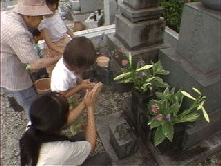Will the Circle Be Unbroken: Japaense Traditions of Death and Rememberace:
(a presentation given to the congregation of
the Unitarian Universalist Church, May 25, 2008)

"Will the circle be unbroken" is a song about mourning the loss of a parent and the hope that she'll have "a better home a-waiting in the sky". The mysterious question in the refrain, however, "Will the Circle Be Unbroken?" is ambiguous. Who is to say to what extent the Circle of Life can be broken or remain unbroken? The original title of the hymn was "Can the Circle Be Unbroken" (Bye and Bye). From a Japanese, and Asian Buddhist, perspective, the Circle of Life is full of pain and suffering and needs to be broken occasionally to achieve a more transcendent life. From a Buddhist perspective, the Circle encompasses all of life, with all of its extremes, within which humans are a part. The Japanese use the term go not the Indian term "karma" to describe one's actions on earth that have ramifications into eternity. Through the prism of our Judeo-Christian-Islamic tradition, go or karma becomes our good works as well as our sinful acts. The reward of breaking the circle of earthly attachments in an ever changing world is Enlightenment or Sattori in this lifetime, and Heaven or Nirvana for eternity (which including the present!). The biggest difference between the two is the belief that spirit, or soul of the deceased person in the Asian tradition continues to transmigrate into different states of existence, or worlds, that do not end with the death of the body. These states can be categorized symbolically as: 1) (Jigoku) Hellish Jail (extreme pain and suffering that mirrors the most sinful actions); 2) (Gaki) Ghosts of unsatisfiable hunger, greed and jealousy; 3) (Chikusho) Animalistic arrogance and selfishness; 4) (Ashura) uncontrollable anger and rage; 5) (Jin) human feelings for each other--two helping each other stand; 6) (Ten) Heavenly feelings, which include some sadness. For the first 49 days (every 7 days for 7 weeks) after death, ten judges determine the fate of the person. Keeping the bones in an earn during this time is common while daily and weekly prayers are given for the deceased. There is a small shrine in the home is kept and used to make offerings of flowers, food, and prayers (small chime and incense). Ceremonies continue at 100 days; 1st year; 3rd year; 7th year; 13th year; 17th year; 23nd; 27th; 33rd. This is the end of the ritual for most families (after 33 years, there usually aren't many people who remember the person, but there are some families who continue the ceremonies up to 50 years). These rituals, seen from a distance can be misunderstood because they appear to be "ancestor worship." In reality it is "training" for the living and the dead. By the end of the training, the deceased can become like a guardian saint of the family. In the process of the training, the survivors learn from the mistakes of the deceased and try to improve their own lives spiritually. For example, at the first year ceremony for Sayuri's grandmother, 22 year ceremony for Sayuri's grandfather and 32 year ceremony for her father was also held. The training for this ceremony for all in attendance considered the seven types of almsgiving that don't require money and can be performed anywhere: 1) Gense (a kind attitude and eye contact); 2) Wagense (Peaceful smile); 3) Gonse (Gentle, caring words. For example, if you share your sorrow with someone, that sorrow will diminsh to half of what it was; and if you share your happiness with someone, that happiness will double through through each person.); 4) Shinse (voluntary, physical labor); 5) Sinse Kokoro (sincere, thoughtful work); 6) Zase (giving up you space, or position for someone); 7) Boushase (providing food and shelter for a traveler, like a home stay). Through the remembrance of the actions of the deceased, one can move more easily between the six realms of existence, and more importantly, help others (including the deceased) move between these realms. The Circle will remain unbroken, but we can make it a little more fluid and bearable. The power of one act of selfless kindness can multiply into the universe and become strong enough to move thousands out of a hellish prison. The Buddhist story, The Spider's Thread, taught in Japanese secondary schools is a memorable example:
The Lord Buddha is walking along the shore of a lotus pond at dawn. The beauty and fragrance pure white petals and golden stamen of the lotus flowers are indescribably satisfying as the Buddha looks down into the pond through two pure white petals. He sees down into the depths of hell, into the pool of blood where sufferers rise and fall trying to reach the mountain of spikes. He sees a murderer and a thief there and remembers that while this person was once walking through the forest, he spared the life of a spider walking along the same road. A spider in the lotus then sent down a silvery thread all the way down to the pool of blood. The murderer takes hold and begins the hard climb out of the depths. After climbing to a point of exhaustion, he looks back to find that thousands of others are taking hold of the same thread on which he is climbing. Horrified by the thought that the thread might break with so many climbing, he yells down that they get off of his thread. At that moment, the thread breaks and everyone, including himself falls back into the pool of blood. Morning has become noon at the Lotus Pond and the Lord Buddha continues his walk along the shore with a hint of sadness.